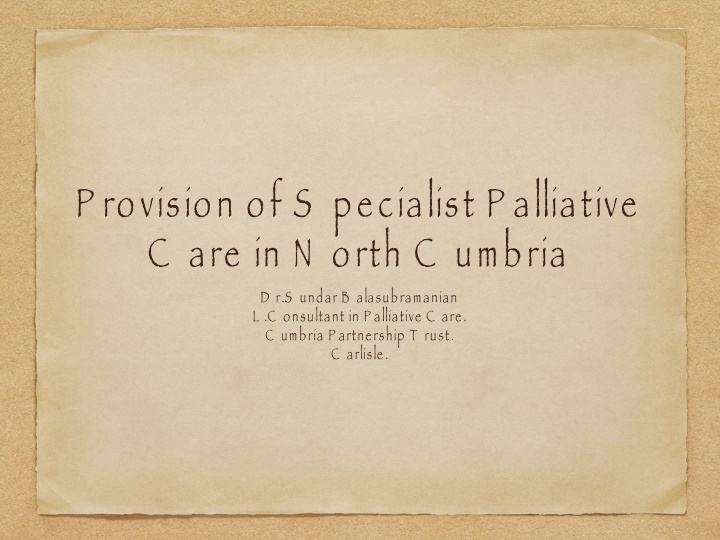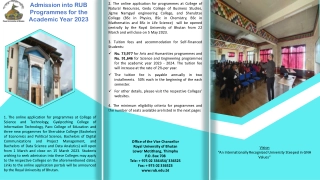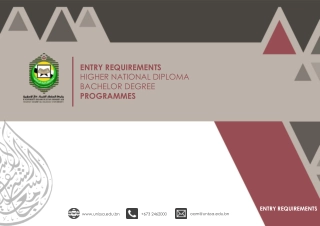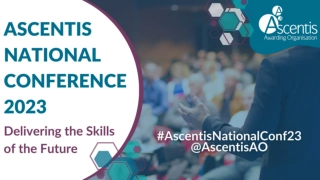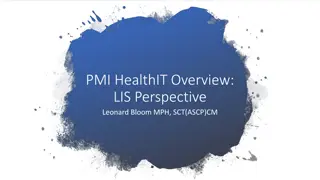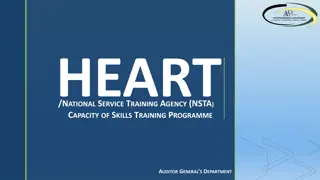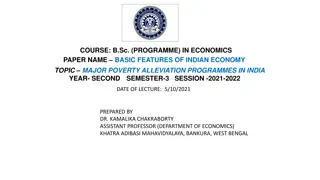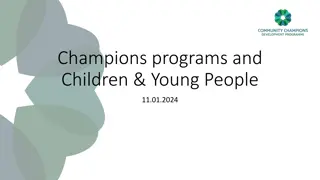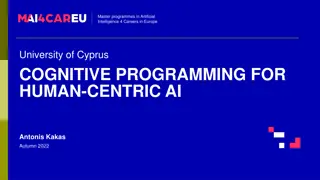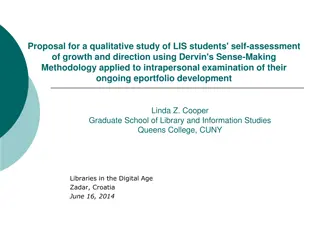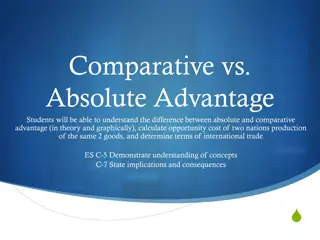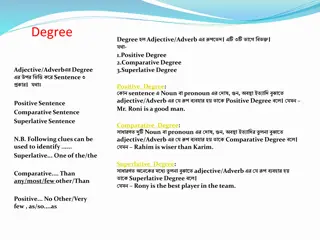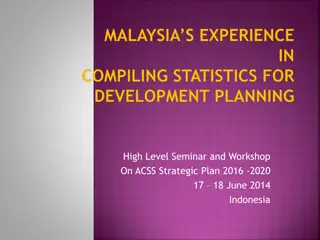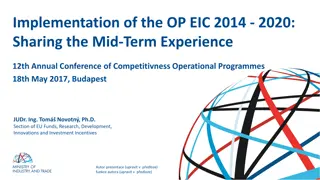Comparative Analysis of LIS Master Programmes
Qualitative comparative project analyzing program structures, frameworks, course descriptions, and more. Includes a literature review and discussion on the balance of theory and practice in curricula elements. Focuses on historical context of LIS education in Scandinavia and development of targeted library schools.
Download Presentation

Please find below an Image/Link to download the presentation.
The content on the website is provided AS IS for your information and personal use only. It may not be sold, licensed, or shared on other websites without obtaining consent from the author.If you encounter any issues during the download, it is possible that the publisher has removed the file from their server.
You are allowed to download the files provided on this website for personal or commercial use, subject to the condition that they are used lawfully. All files are the property of their respective owners.
The content on the website is provided AS IS for your information and personal use only. It may not be sold, licensed, or shared on other websites without obtaining consent from the author.
E N D
Presentation Transcript
P rovision of S pecialist P alliative C are in N orth C umbria D r.S undar B alasubramanian L .C onsultant in P alliative C are. C umbria P artnership T rust. C arlisle.
M yth N o.1 P alliative care equates to E nd of L ife C are
M yth N o:2 H ospice is a one way ticket.
Integration of S ervices & P rovision of P alliative care for M N D patients in N orth C umbria( E den V alley H ospice & C ommunity). S upport provided by the day hospice for patients and their carers. A dvance C are P lanning. P alliation and management of symptoms in M N D patients
Integration of S ervices 6 M N D P rofessional forums / year in carlisle R epresentation from P alliative C are, M N D team, C linical N europsychology, P hysio, O T s, S ocial W orker, C omplimentary T herapists,orthotics,S A L T &D ieticians. newly appointed M N D coordinator.
M D T -P rofessional forum discuss the psychological and emotional impact of M N D on the person whether they have any psychological or support care needs. discuss about how they are coping with the diagnosis and prognosis, including any concerns regarding physical symptoms that they might have expressed to the health care professionals. F ollowing the meeting, we are a part of the joint clinic with D r.W illiams and his team
A t what stage in the illness ( M N D ), do you think patients need to be referred to P alliative care services?
Involvement of S pecialist P alliative care in the care of people with M N D R elatively rare but has devastating effects with quick progression and a poor prognosis. O B rien et al showed that many symptoms of patients with M N D are similar to those experienced by patients with advanced cancer. T he hospice approach puts an emphasis on living rather than dying (R E M E M B E R T H E M Y T H ) T he approach is based on C A R E as opposed to C U R E . M N D is N O T automatically linked in people s mind with palliative care and the hospice movement, but an increasing number of people with the condition are benefiting from the services offered by the hospices.
A dvance C are P lanning(A C P ) T he E O L strategy (D oH )suggests that A C P can be helpful in finding out patient preferences regarding their care and setting, and can take the form of a statement of wishes/ preferences or may be an advance decision to refuse a specific treatment. (It also states that people do not need to plan in this way if they do not want to.)
T he opportunity to talk openly with loved ones,having received a terminal diagnosis, is often welcomed by patients who are keen to put their affairs in order and minimise the distress for their families and loved ones. T hese patients often benefit from having a D N A C P R form
J ournal A ssisting patients with M N D to make decisions about their care. (International J ournal of P alliative N ursing,2 01 5 )
A more flexible approach focusing on the agenda set by the patient,underpinned by the therapeutic and trusting relationship, can avoid distress for the patient,while ensuring good care and the best outcome for the patient.
D ay care/ S unflower group 6 week programme is designed to help carers cope with some of the difficulties that result from supporting and caring, and provides an opportunity to meet other carers in a similar position
M anagement of S ymptoms H ow people respond to the disease will depend most significantly upon previous lifestyle and aspirations ( the loss of which can cause feelings of bereavement ) E ffective symptom control: M ain goal. S upport from multitude of services/ M D T
R espiratory impairment E pisodes of dyspnoea and anxiety may respond to the use of B enzodiazepines and O pioids. J ust in case kit to alleviate fear associated with dyspnoea,choking and panic. P ositioning of the patient is crucial to reduce pressure on the diaphragm from abdominal organs.( 1 0% head up tilt/ sitting up)
chocking D eath through chocking in M N D is extremely rare. T he word C hocking misused in the context of M N D , invoking feelings of feared anxiety in patients and carers
S ialorrhoea R esult of impaired swallowing or poor lip seal. D istressing/ E mbarrassing- W ith draw from the society. C an also lead to aspiration-C hest infection. A nticholinergics+ N on pharmacological interventions
N utrition R educed upper body strength and dexterity can lead to difficulties with eating and drinking. S upport from S A L T for assessment and intervention. If P E G tube needs to be considered ,patients F V C should be greater than 5 0%.
M obility M uscle wasting &weakness-leads to impaired mobility, repeated falls and risk of injury-wheel chair/ specialised seating systems. A nti spasmodics and physiotherapy may reduce stiffness and spasticity.
42 year old lady diagnosed with M N D , complains of severe abdominal pain, which started around the umbilicus and travelled towards the right lilac fossa. S he has associated vomiting. W hat is the possible diagnosis?
P ain R ange of factors Immobility, P ressure on the skin &joint stiffness. A ccording to W H O analgesic ladder.
cognition A round 3 5 % experience mild cognitive change-affect executive functions like planning, decision making. A further 1 5 % show signs of front temporal dementia, which results in behavioural changes. T hought generation, word finding, planning, learning new activities and concentration are affected. A reas of deficit identified and suitable strategies to be developed.
continence constipation due to various factors. risk of U T I- can be detrimental.
communication difficulties distressing to loose voice as a result of increased bulbar muscle involvement and reduced respiratory function. voice banking- synthetic version.
E motional L ability 6 5 year old man diagnosed with M N D attends the day hospice. M any a times he laughs uncontrollably. It could sometimes sound inappropriate and he is left embarrassed. H ow would you treat it?
E motional L ability P seudo bulbar effect- laughs or cries easily. N eed to be reassured that it is a symptom of the disease and not a sign of cognitive involvement. F luoxetine .
work &finance Increasing disability can lead to loss of self esteem, increased frustration and fears about finances P IP / A ttendance allowance- N on means tested.
E nd of L ife care Important to recognise the terminal stages. M ay need medications via syringe driver/ J ust in case medications.
social services homeware for people with M N D S W at the hospice. M any patients do not access this service. Internal issues: R etaining control & normality within the home. E xternal issues: L imited understanding of the disease amongst service providers and the lack of awareness of service entitlement amongst patients and carers.
S taff support F rustrations and difficulties inherent in working with people with such a distressing illness. S taff need support for several reasons heavy and time consuming burden of physical care. B eing the butt of patient s frustrations at not being able to help themselves can be personally demoralising if not interpreted within the correct context.
R emember the M yth C onsider referral to S pecialist P alliative care team for people with current or anticipated significant or complex needs, e.g., psychological or social distress, troublesome or rapidly progressing symptoms ,complex future care planning needs and for E nd of L ife care.
useful contact numbers E den V alley H ospice(E V H ): 01 2 2 8 8 1 08 01 M edical S ecretary:01 2 2 8 6 08 2 48 C ommunity N urse S pecialists: 01 2 2 8 6 02 09 8 D ay H ospice/ S unflower group: 01 2 2 8 8 1 7 6 2 3
R eference P alliative care in M S and M N D , B ritish J ournal of H ospital M edicine, J an 2 01 0, V ol7 1 H ospice care in M N D , N ursing standard, V ol9 ,1 9 9 4 A ssisting patients with M N D to make decisions about their care, International journal of P alliative N ursing, 2 01 5 , vol 2 1 . S ocial services home care for people with M N D :why such services are refused? E thical issues in P alliative C are-an overview; P alliative M edicine 1 9 9 3 ;7 (suppl 2 );1 5 -2 0 M N D :an overview; L earning Z one C P D vol2 6 no 46 ;2 01 2
